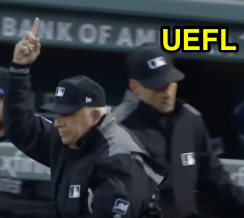We received an Ask the UEFL question about the Replay Official's decision to uphold Rackley's call of "fair ball/HR" all while a camera angle from the stands up along the first baseline suggested the batted ball may have been foul.
What happened here and why did this call stand?
 |
| Replay Review lost sight of a high fly ball. |
To counteract the parallax deception, baseball relies on another law of physics related to vision: if the ball crosses in front of the foul pole, the ball is therefore closer to the viewer than the pole at the point at which it crosses the pole. Ordinarily, for a viewer watching the ball/pole interaction from the playing field (as an umpire or player would), this is a shortcut to say that a ball crossing in front of the pole and leaving the playing field in flight is a fair ball and home run.
Conversely, a ball crossing behind the pole suggests it is farther away from the viewer than the pole at the point of intersection, which would suggest a foul ball.
 |
| Parallax proves certain replays unreliable. |
Due to his angle from the playing field surface up the left field line, 3B Umpire Rackley thus was in the best position of any person to observe the ball as it arrived at the planar edge of the Green Monster, meaning that MLB referred to his on-field ruling of "home run" for lack of evidence to indicate otherwise.
Related Post: Ask UEFL - Judging a Fly Ball as Fair or Foul (Video) (7/13/18).
Video as follows:
Alternate Link: UEFL analysis and explanation regarding parallax angle & "call stands" (UEFL)
Second Video: Michael Chavis hits a solo home run in the 2nd that stands after review (BOS)
